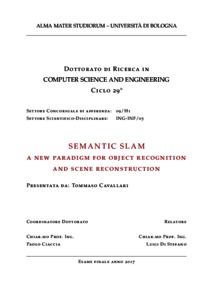Cavallari, Tommaso
(2017)
Semantic Slam: A New Paradigm for Object Recognition and Scene Reconstruction, [Dissertation thesis], Alma Mater Studiorum Università di Bologna.
Dottorato di ricerca in
Computer science and engineering, 29 Ciclo. DOI 10.6092/unibo/amsdottorato/7954.
Documenti full-text disponibili:
![Cavallari_Tommaso_Tesi.pdf [thumbnail of Cavallari_Tommaso_Tesi.pdf]](https://amsdottorato.unibo.it/7954/1.hassmallThumbnailVersion/Cavallari_Tommaso_Tesi.pdf)  Anteprima |
Documento PDF (English)
- Richiede un lettore di PDF come Xpdf o Adobe Acrobat Reader
Disponibile con Licenza: Salvo eventuali più ampie autorizzazioni dell'autore, la tesi può essere liberamente consultata e può essere effettuato il salvataggio e la stampa di una copia per fini strettamente personali di studio, di ricerca e di insegnamento, con espresso divieto di qualunque utilizzo direttamente o indirettamente commerciale. Ogni altro diritto sul materiale è riservato.
Download (25MB)
| Anteprima
|
Abstract
Simultaneous localisation and mapping (SLAM) is a technique studied in computer vision and robotics that, given measurements obtained from one or more sensors, allows incremental building of a map of the environment and simultaneous estimation of the position and orientation of the very same sensor used to acquire the input data.
Visual SLAM systems typically allow the generation of accurate reconstructions of the explored environment but, until very recently, did not provide high level informations on the contents of the reconstructed scenes, useful to foster high level reasoning by subsequent algorithms.
In this thesis we focus on the topic of Semantic SLAM, proposing techniques to obtain semantically accurate reconstructions of the explored environment by combining efficient SLAM systems with state-of-the-art semantic image segmentation algorithms.
We show how, by relying on such semantic reconstructions, the accuracy of the localisation phase of a SLAM pipeline can improve, by accounting for the presence of semantic informations during the camera pose estimation step.
We thus realise a "semantic loop", where the availability of high level clues betters the mapping process, in turn helping the subsequent localisation phase.
A full system, drawing inspiration from the presented research, allowing a real-time and automatic semantic mapping of large-scale environments is then presented.
An ancillary, but nevertheless important, component of simultaneous localisation and mapping systems is a technique to allow the estimation of sensor position separately from the main SLAM loop, to recover from failures in the localisation algorithm.
We present a technique that, by exploiting the appearance of image patches, can reliably localise the likely position of the sensor used to acquire such images.
Such relocalisation system can be easily included in a Semantic SLAM system to allow a more robust mapping process wherein camera tracking failures can be reliably recovered from.
Abstract
Simultaneous localisation and mapping (SLAM) is a technique studied in computer vision and robotics that, given measurements obtained from one or more sensors, allows incremental building of a map of the environment and simultaneous estimation of the position and orientation of the very same sensor used to acquire the input data.
Visual SLAM systems typically allow the generation of accurate reconstructions of the explored environment but, until very recently, did not provide high level informations on the contents of the reconstructed scenes, useful to foster high level reasoning by subsequent algorithms.
In this thesis we focus on the topic of Semantic SLAM, proposing techniques to obtain semantically accurate reconstructions of the explored environment by combining efficient SLAM systems with state-of-the-art semantic image segmentation algorithms.
We show how, by relying on such semantic reconstructions, the accuracy of the localisation phase of a SLAM pipeline can improve, by accounting for the presence of semantic informations during the camera pose estimation step.
We thus realise a "semantic loop", where the availability of high level clues betters the mapping process, in turn helping the subsequent localisation phase.
A full system, drawing inspiration from the presented research, allowing a real-time and automatic semantic mapping of large-scale environments is then presented.
An ancillary, but nevertheless important, component of simultaneous localisation and mapping systems is a technique to allow the estimation of sensor position separately from the main SLAM loop, to recover from failures in the localisation algorithm.
We present a technique that, by exploiting the appearance of image patches, can reliably localise the likely position of the sensor used to acquire such images.
Such relocalisation system can be easily included in a Semantic SLAM system to allow a more robust mapping process wherein camera tracking failures can be reliably recovered from.
Tipologia del documento
Tesi di dottorato
Autore
Cavallari, Tommaso
Supervisore
Dottorato di ricerca
Ciclo
29
Coordinatore
Settore disciplinare
Settore concorsuale
Parole chiave
real-time RGB-D SLAM, 3D surface reconstruction, SLAM, depth map fusion, KinectFusion, simultanous localisation and mapping, semantic SLAM, camera relocalisation, random forests, camera pose estimation, semantic segmentation, semantic mapping
URN:NBN
DOI
10.6092/unibo/amsdottorato/7954
Data di discussione
15 Maggio 2017
URI
Altri metadati
Tipologia del documento
Tesi di dottorato
Autore
Cavallari, Tommaso
Supervisore
Dottorato di ricerca
Ciclo
29
Coordinatore
Settore disciplinare
Settore concorsuale
Parole chiave
real-time RGB-D SLAM, 3D surface reconstruction, SLAM, depth map fusion, KinectFusion, simultanous localisation and mapping, semantic SLAM, camera relocalisation, random forests, camera pose estimation, semantic segmentation, semantic mapping
URN:NBN
DOI
10.6092/unibo/amsdottorato/7954
Data di discussione
15 Maggio 2017
URI
Statistica sui download
Gestione del documento:


 Login
Login
